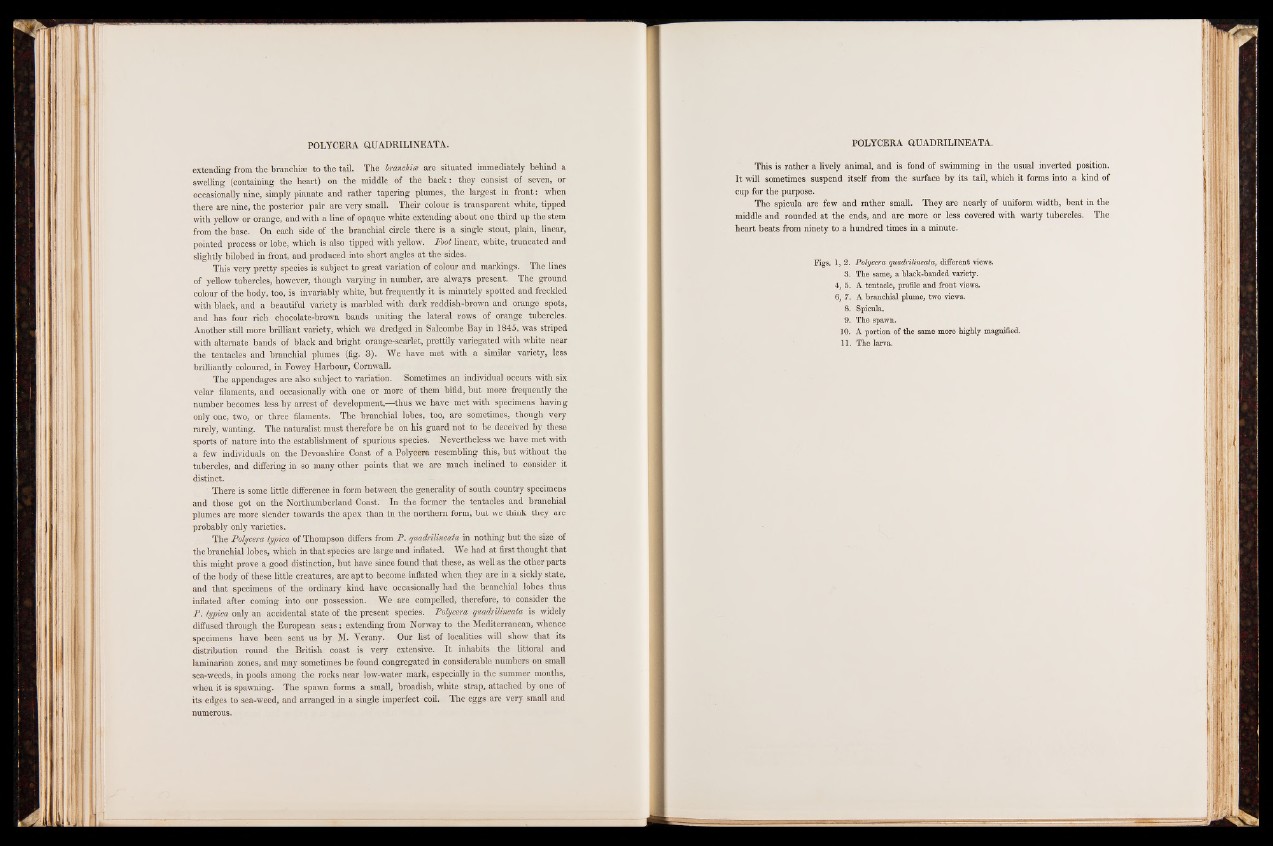
extending from the branchim to the tail. The branchice are situated immediately behind a
swelling (containing the heart) on the middle of the back: they consist of seven, or
occasionally nine, simply pinnate and rather tapering plumes, the largest in front: when
there are nine, the posterior pair are very small. Their colour is transparent white, tipped
with yellow or orange, and with a line of opaque white extending about one third up the stem
from the base. On each side of the branchial circle there is a single stout, plain, linear,
pointed process or lobe, which is also tipped with yellow. Foot linear, white, truncated and
slightly bilobed in front, and produced into short angles at the sides.
This very pretty species is subject to great variation of colour and markings. The lines
of yellow tubercles, however, though varying in number, are always present. The ground
colour of the body, too, is invariably white, but frequently it is minutely spotted and freckled
with black, and a beautiful variety is marbled with dark reddish-brown and orange spots,
and has four rich chocolate-brown bands uniting the lateral rows of orange tubercles.
Another still more brilliant variety, which we dredged in Salcombe Bay in 1845, was striped
with alternate bands of black and bright orange-scarlet, prettily variegated with white near
the tentacles and branchial plumes (fig. 3). We have met with a similar variety, less
brilliantly coloured, in Fowey Harbour, Cornwall.
The appendages are also subject to variation. Sometimes an individual occurs with six
velar filaments, and occasionally with one or more of them bifid, but more frequently the
number becomes less by arrest of development,— thus we have met with specimens having
only one, two, or three filaments. The branchial lobes, too, are sometimes, though very
rarely, wanting. The naturalist must therefore be on his guard not to be deceived by these
sports of nature into the establishment of spurious species. Nevertheless we have met with
a few individuals on the Devonshire Coast of a Polycera resembling this, but without the
tubercles, and differing in so many other points that we are much inclined to consider it
distinct.
There is some little difference in form between the generality of south country specimens
and those got on the Northumberland Coast. In the former the tentacles and branchial
plumes are more slender towards the apex than in the northern form, but we think they are
probably only varieties.
The Polycera typica of Thompson differs from P. quadrilineata in nothing but the size of
the branchial lobes, which in that species are large and inflated. We had at first thought that
this might prove a good distinction, but have since found that these, as well as the other parts
of the body of these little creatures, are apt to become inflated when they are in a sickly state,
and that specimens of the ordinary kind have occasionally had the branchial lobes thus
inflated after coming into our possession. We are compelled, therefore, to consider the
P. typica only an accidental state of the present species. Polycera quadrilineata is widely
diffused through the European seas ; extending from Norway to the Mediterranean, whence
specimens have been sent us by M. Yerany. Our list of localities will show that its
distribution round the British coast is very extensive. It inhabits the littoral and
laminarian zones, and may sometimes be found congregated in considerable numbers on small
sea-weeds, in pools among the rocks near low-water mark, especially in the summer months,
when it is spawning. The spawn forms a small, broadish, white strap, attached by one of
its edges to sea-weed, and arranged in a single imperfect coil. The eggs are very small and
numerous.
This is rather a lively animal, and is fond of swimming in the usual inverted position.
It will sometimes suspend itself from the surface by its tail, which it forms into a kind of
cup for the purpose.
The spicula are few and rather small. They are nearly of uniform width, bent in the
middle and rounded at the ends, and are more or less covered with warty tubercles. The
heart beats from ninety to a hundred times in a minute.
Figs. 1, 2.
3.
4, 5.
6, 7.
9.
10.
11.
Polycera quadrilineata, different views.
The same, a black-banded variety.
A tentacle, profile and front views.
A branchial plume, two views.
Spicula.
The spawn.
A portion of the same more highly magnified.
The larva.